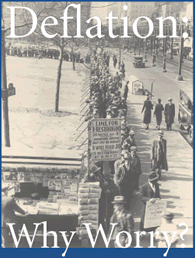Now that economic recovery appears under way, the media aren't talking about deflation any longer. But economists are. Many leading economists still consider deflation a serious threat to be avoided diligently. But others argue that a modest amount of deflation is actually optimal. So the issue remains central to monetary policy: How concerned should Federal Reserve policymakers be about deflation? Should they build firebreaks to prevent it? Or should they focus their attention on more pressing problems?
 On Nov. 25, six prominent economists gathered at the Minneapolis Fed for a half-day symposium to
address precisely these concerns in the company of officers
and staff from the Federal Reserve banks of Cleveland, Kansas
City, Minneapolis and New York. The session began with an introduction
and overview by two Minneapolis Fed economic advisers: Ellen
McGrattan, who moderated the workshop, and Patrick
Kehoe, who gave the opening presentation.
On Nov. 25, six prominent economists gathered at the Minneapolis Fed for a half-day symposium to
address precisely these concerns in the company of officers
and staff from the Federal Reserve banks of Cleveland, Kansas
City, Minneapolis and New York. The session began with an introduction
and overview by two Minneapolis Fed economic advisers: Ellen
McGrattan, who moderated the workshop, and Patrick
Kehoe, who gave the opening presentation.
Kehoe's talk focused on the empirical link between deflation and depression. He displayed a graph with inflation rates on one axis and gross domestic product growth on the other and then plotted points representing the inflation/GDP growth experiences of a sample of 15 countries over 100 years at five-year intervals. There were indeed a number of episodes when nations experiencing deflation also suffered depression, he said. But there were far more points in time when these nations enjoyed economic growth along with deflation, said Kehoe, as well as growth or depression with inflation. His overall conclusion: "I see essentially no empirical link between deflation and depression."
Why worry?
Then the six invited economists spoke in turn, each for 20 minutes, laying out their arguments about deflation. The first panelist, Lee Ohanian from the University of California, Los Angeles, argued that the Great Depression—often held up as the key example of how deflation causes economic depression—was in fact not caused primarily by deflation. "To understand the Great Depression story," he said, "we need to move beyond the single shock theory." According to his analysis of 17 industrialized countries, "a conservative estimate" is that 66 percent of the decline in national economic output from 1930 to 1933 was due to declines in productivity (including factors affecting how businesses utilize capital and labor), not deflation. In 1930, in fact, 95 percent of the drop in output could be accounted for by productivity shocks.
Narayana Kocherlakota from Stanford University followed with a theoretical discussion which, in essence, argued for the desirability of a nominal interest rate of zero. According to public finance economics, he said, the taxation of intermediate goods creates production inefficiency. Money is an intermediate good—something used to produce or acquire other goods—so taxing it through government-determined interest rates causes economic distortion. More simply put, interest rates above zero cause a bias against holding cash—they're a tax on activities that require currency, "like buying hot dogs," he joked. Kocherlakota argued that monetary policy that sets interest rates at a positive level is often trying to achieve goals that could be reached more efficiently through fiscal policy. "My basic theme," he said, "is that monetary policy shouldn't be thought of in isolation."
V.V. Chari from the University of Minnesota gave an overview of current monetary theory regarding deflation and elaborated on the "Friedman rule." In 1969, Milton Friedman argued that optimal monetary policy requires "a rate of price deflation that makes the nominal rate of interest equal to zero." Since the real interest rate is usually positive, the only way to get the nominal rate to zero is to achieve deflation. In most cases, said Chari, a Friedman rule is indeed optimal policy, implying that the inflation rate should be between -3 percent and 0 percent. The problems of large deflations shouldn't be dismissed, he admitted. Inefficiencies are possible. But a suitably augmented Friedman rule is still optimal policy. The important lesson, Chari said, is that commitment to a policy is essential, but since there is no consensus on a detailed policy rule, it would be best to pick a rule for, say, three years, and then require the vote of a majority of the Federal Reserve's Federal Open Market Committee members before deviating from that rule. "It's modest with respect to what we know and what we do not," he added.
Deflation hawks
Deflation critics then took the floor. Marvin Goodfriend, senior vice president and policy adviser at the Richmond Fed, laid out a detailed theoretical model that combined elements of Keynesian and classical schools of macroeconomic theory. He then argued that there are many deflationary threats: sustained and unexpected productivity growth, excessive investment booms and pessimism about future taxes. If the nominal interest rate is zero or close to it, he said, firms and households will doubt that interest rate policy can restore economic health. "That credibility problem has the potential to create a 'deflation scare,'" said Goodfriend, and reestablishing credibility is extremely difficult. "Until central banks learn how to overcome the zero bound ... and acquire credibility for doing so," he concluded, "it is reasonable for central banks to defend a 1 percent lower bound on inflation."
Ben Bernanke, a member of the Board of Governors of the Federal Reserve Board and former chairman of Princeton University's economics department, has warned about the need to guard against deflation, and he reiterated those thoughts at the workshop. Reviewing data on deflations in the United States prior to the Great Depression, most of which occurred under the gold standard, he agreed that "deflation was not incompatible with growth" during that period, "but [it was] probably a drag on net." As for the Great Depression, he cited the current consensus among economic historians, based on the experience not only of the United States but of many other countries as well, that monetary contraction and deflation played a central role in that episode.
According to Bernanke, one of the greatest dangers of deflation is that it will force the nominal interest rate to its lower bound of zero, distorting financial markets and hamstringing monetary policy. He emphasized that monetary policy is far from helpless when nominal interest rates are zero, but that the policies available to central banks when interest rates are zero are relatively untested and unfamiliar, so that avoiding deflation in the first place is the wisest course. Finally, he noted that Milton Friedman's argument for aiming for deflation in the long run assumes that the only effect of changes in the aggregate price level on the economy is on the opportunity cost of holding cash. Taking into account other effects of a changing aggregate price level, such as the tendency to distort relative prices and make planning more difficult, and also considering the likely biases in inflation measurement, central banks are better off aiming for a low but positive measured rate of inflation.
Robert Lucas, a Nobel laureate, University of Chicago economist and adviser to the Minneapolis Fed, was the last speaker. He focused on the relative utility of relying on interest rate policy or money growth policy. The Fed has usually concentrated on the former, but the latter deserves more attention. "Discussing monetary policy entirely in terms of interest rates," he noted, "leads us to describe situations of very low interest rates as situations where the central bank is helpless to raise inflation rates, when in fact they are not helpless at all." The European Central Bank, said Lucas, is discussing monetary aggregates and interest rates in practical ways that aren't at all preoccupied with deflation.
No resolution, but progress
Between presentations, the audience weighed in with questions and discussion, and it wasn't a timid crowd. Data were doubted, assumptions judged, models found lacking. At the end of the day, the presentations and discussion had by no means resolved the deflation debate. But the workshop did reinforce some shared understandings and usefully brightened the lines of disagreement. One of the largest fault lines ran between the optimal and the pragmatic, between what theoreticians laid out as desirable and policymakers thought achievable. For example, Bernanke responded to the theorists' argument that many of the costs of deflation could be ameliorated by time-varying consumption taxes by noting that such subtle policies are unlikely to be implemented in practice. Hence, the central bank must do the best it can, given the fiscal and economic environment in which it finds itself.
Nonetheless, there was solid agreement that credibility is key to successful monetary policy, and it was clear from the workshop that credibility and consensus in dealing with deflation can only be achieved over time, not overnight. "Today's workshop advanced the discussion," observed Gary Stern, president of the Minneapolis Fed. "Ultimately, this is how we improve policy: with solid research and serious debate."
Workshop Papers
Optimal Monetary Policy Theory and Lessons, V.V. Chari [PPT]
The Deflation Threat in the New Neoclassical
Synthesis,
Marvin Goodfriend [PPT]
Deflation and Depression: Is There
an Empirical Link?,
Patrick Kehoe [PDF]
The Great Deflation Debate, Narayana Kocherlakota [Doc]
Deflation and the Zero Interest Bound, Robert E. Lucas [PPT]
The Macroeconomic Consequences of Big Deflations,
Lee E. Ohanian [PDF]





